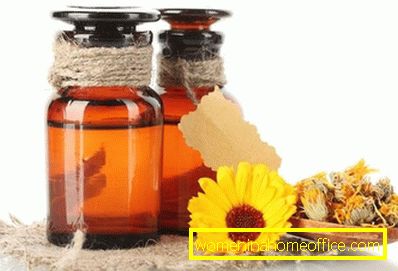Marigold
Marigold - a plant from the Compositae family, easily recognizable in spring by yellow or orange colors. They are very fond of sunlight, for good reason their name literally means “after the sun” in Latin. This small plant has been known for its beneficial properties for many centuries. So, marigold: medicinal properties and contraindications.
What is the secret of medicinal marigold?

Marigold - a favorite herbal medicine plant, known for its soothing and healing properties, primarily aimed at solving small skin problems. They also relieve an upset stomach, liver, sore throat, premenstrual pain syndrome.
Marigolds bloom from spring to late frosts and are valued as an ornamental plant, as well as an aid against garden aphids. Some cooks feel free to include them in their recipes, as the flower is edible. Herbal medicine uses only flowers, fresh or dried, which are harvested in the summer immediately after opening.
Marigolds consist of such components and active ingredients:
- flavonoids;
- esters;
- carotenoids;
- manganese;
- essential oil;
- saponin and carofillin derivatives;
- salicylic acid;
- adhesives - tar, mucus;
- organic acids;
- bitter substances;
- polyphenols;
- tannins;
- sterols;
- triterpene alcohols;
- immunostimulating polysaccharides.
Esters and triterpene alcohols have anti-inflammatory and healing effects. Saponins have an anti-edematous effect. Flavonoids and carotenoids, in turn, have an antioxidant effect. Salicylic acid acts as an analgesic. Slime adds moisturizing properties. Essential oil is known for its antibacterial action.
Marigold: useful properties and contraindications

Due to its composition, marigolds have a wide range of applications. They can be used both internally and externally. The main forms of drugs from marigolds are presented in the form of a cream, gel, ointment, balm, tincture, oil, drops. In herbal medicine, the plant is often used as an external agent. It is strongly recommended to read the instructions for use before using a drug.
Therapeutic indications for the external use of drugs from marigolds, primarily related to mild skin problems. Their skin benefits include properties such as:
- softening and moisturizing dry and reactive, sensitive skin, diaper rash, seborrhea in infants and young children;
- soothing, regenerating, antioxidant effect on abrasions, cuts, cracks, minor burns, including sunburns;
- cleansing, antibacterial, healing effect on small wounds, including those with an infection;
- anti-inflammatory, anti-edema action or relief of pain from minor burns, insect bites, urticaria and bruising.
In ophthalmology, marigolds are used in the treatment of conjunctivitis. For internal use, they are shown in such cases:
- to normalize the menstrual cycle, relieve pain in this period;
- to cleanse the liver;
- to eliminate gastric inflammation in gastritis and digestive disorders;
- with fever, sore throat, infections in the mouth, myalgia.
Precautionary measures

Internal use of drugs on the basis of marigold is allowed only after consultation with a doctor or a specialist in the field of herbal medicine. Such treatment should not last more than two weeks and is contraindicated during pregnancy, lactation, as well as children under 6 years of age.
For external use, prolonged use of alcohol tinctures may result in skin irritation. In addition, allergies are possible in people susceptible to marigold components.
If you decide to make your own home medicine from marigolds, please note that this plant can be confused with marigolds, marsh marigold or buttercup. In addition, there is a wild form of marigold - Arvensis. Anyway, consultation of the expert is necessary not to be mistaken with the choice of medicinal plants.
Are marigold and calendula the same thing?
Let us tell you a little secret: under the name of the marigold, the calendula plant is hidden. Actually, calendula is the main name of this flower. However, it should not be confused with marigolds or Chernobrids, belonging to the Aster family.
Remember, a real calendula is an annual plant with an erect stem. The whole plant is covered with down. If the bush or leaves are damaged, it exudes a distinctive, distinct smell. The leaves have an oblong regular or slightly irregular shape and surround the stem. The lower part of the stem is left without leaves. The leaves are soft and fleshy, reaching a length of 7 cm.
The flowers form heads with a diameter in the range from 3 to 10 cm. Often they do not produce a core like a chamomile. Flowers can be of different shades: from pale yellow to dark orange, they open and close with the sun. Flowering lasts several weeks and lasts until frost.
The evidence of the beneficial and healing properties of marigold is recognized even by health care. Many biological additives, personal hygiene products, including those for child care, contain components of calendula. It is a safe plant that fits perfectly into a home first aid kit.